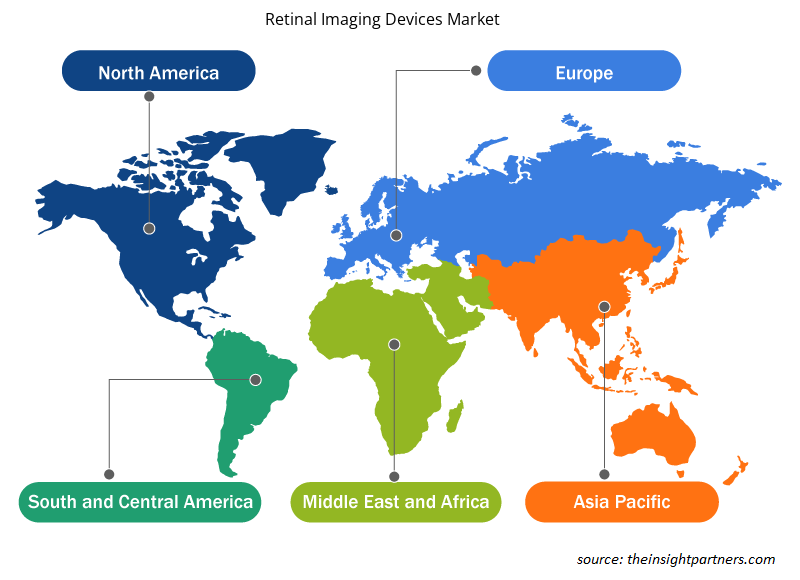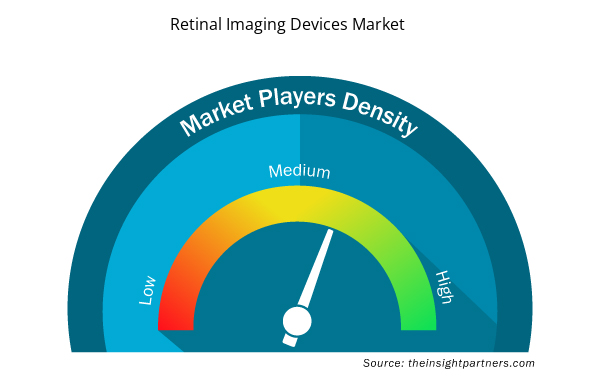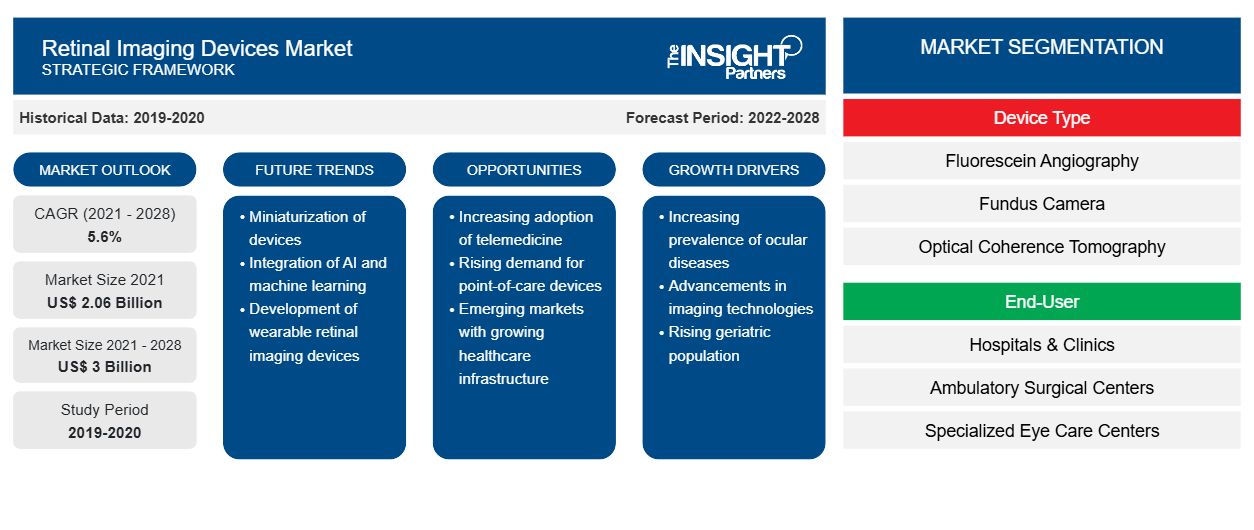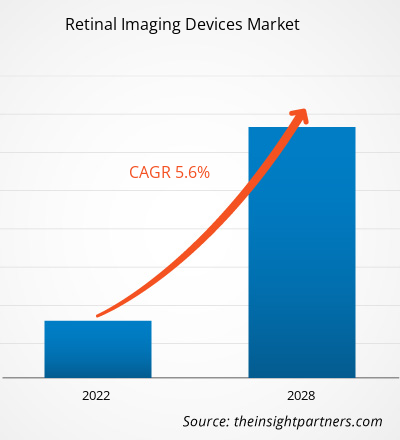Si prevede che il mercato dei dispositivi di imaging retinico raggiungerà i 3,00 miliardi di dollari entro il 2028, rispetto ai 2,06 miliardi di dollari del 2021; si stima che crescerà a un CAGR del 5,6% nel periodo 2021-2028.
L'imaging retinico è una tecnica utilizzata per analizzare e diagnosticare le condizioni della retina di un paziente. I dispositivi di imaging retinico (RID) utilizzano sistemi di imaging ad alta risoluzione per catturare immagini interne di un occhio. L'immagine catturata aiuta i dottori della rete Virtual Private Network (VSP) a valutare la salute della retina, il che aiuta nella rilevazione e gestione di condizioni oculari e di salute come diabete, glaucoma e degenerazione maculare, tra gli altri.
Personalizza questo report in base alle tue esigenze
Riceverai la personalizzazione gratuita di qualsiasi report, comprese parti di questo report, o analisi a livello nazionale, pacchetto dati Excel, oltre a usufruire di grandi offerte e sconti per start-up e università
- Scopri le principali tendenze di mercato in questo rapporto.Questo campione GRATUITO includerà analisi di dati che spaziano dalle tendenze di mercato alle stime e alle previsioni.
La crescita del mercato dei dispositivi di imaging retinico è attribuita al migliorato accesso degli oculisti alla retina, alle crescenti iniziative globali per la cecità e ai progressi tecnologici. Tuttavia, l'elevato costo dei dispositivi OCT ostacola la crescita del mercato.
Approfondimenti di mercato
Aumento della prevalenza delle malattie degli occhi
I dispositivi di imaging retinico sono ampiamente utilizzati per diagnosticare e trattare varie malattie oculari come retinopatia diabetica , degenerazione maculare legata all'età, glaucoma, melanoma oculare e lievi problemi di vista. Inoltre, in tutto il mondo, la preoccupazione per la cecità o la compromissione della vista sta crescendo in modo significativo. Secondo i dati pubblicati dall'Organizzazione mondiale della sanità (OMS) nell'ottobre 2021, quasi 2,2 miliardi di persone vivono con una compromissione della vista o cecità. Tra questi, circa un miliardo di casi di compromissione della vista possono essere prevenuti con una diagnosi e un trattamento adeguati. Questo miliardo di persone ha diversi problemi agli occhi correlati a una compromissione della vista da lontano moderata o grave o alla cecità. Le tecnologie diagnostiche correlate alle immagini hanno iniziato a offrire una crescita senza precedenti delle malattie oculari basate su set di dati morfologici. Si prevede che tale fattore aiuterà il mercato dei dispositivi di imaging retinico nel periodo di previsione.
Informazioni basate sul tipo di dispositivo
In base al tipo di dispositivo, il mercato globale dei dispositivi di imaging retinico è stato segmentato in angiografia con fluoresceina, fundus camera e tomografia a coerenza ottica. Il segmento fundus camera ha detenuto la quota maggiore del mercato nel 2021. La fotografia del fundus si è trasformata da flash elettronici a fotocamere basate su smartphone a un più recente kit portatile per l'esame della vista (PEEK). PEEK è un'applicazione basata su smartphone per un esame della vista completo. Il vantaggio di queste fotocamere è che un non oculista può scattare foto e, con un po' di formazione, anche classificarle. Tuttavia, si prevede che il segmento della tomografia a coerenza ottica registrerà il CAGR più alto dell'8,1% nel mercato durante il periodo di previsione. La tomografia a coerenza ottica consente la valutazione di diversi livelli di ischemia maculare che non vengono diagnosticati nell'imaging primario. La tecnica è utilizzata come standard per le modalità di imaging per gli occhi.
Approfondimenti basati sull'utente finale
In base all'utente finale, il mercato globale dei dispositivi di imaging retinico è segmentato in ospedali e cliniche, cliniche specialistiche, centri di assistenza ambulatoriale e altri. Il segmento ospedali e cliniche ha detenuto la quota maggiore del mercato nel 2021 e si prevede che i centri di cura oculistica specializzati registreranno il CAGR più elevato del 6,6% nel mercato durante il periodo di previsione.
Approfondimenti regionali sul mercato dei dispositivi di imaging retinico
Le tendenze regionali e i fattori che influenzano il mercato dei dispositivi di imaging retinico durante il periodo di previsione sono stati ampiamente spiegati dagli analisti di Insight Partners. Questa sezione discute anche i segmenti e la geografia del mercato dei dispositivi di imaging retinico in Nord America, Europa, Asia Pacifico, Medio Oriente e Africa e America meridionale e centrale.

- Ottieni i dati specifici regionali per il mercato dei dispositivi di imaging retinico
Ambito del rapporto di mercato sui dispositivi di imaging retinico
| Attributo del report | Dettagli |
|---|---|
| Dimensioni del mercato nel 2021 | 2,06 miliardi di dollari USA |
| Dimensioni del mercato entro il 2028 | 3 miliardi di dollari USA |
| CAGR globale (2021 - 2028) | 5,6% |
| Dati storici | 2019-2020 |
| Periodo di previsione | 2022-2028 |
| Segmenti coperti | Per tipo di dispositivo
|
| Regioni e Paesi coperti | America del Nord
|
| Leader di mercato e profili aziendali chiave |
|
Densità degli attori del mercato dei dispositivi di imaging retinico: comprendere il suo impatto sulle dinamiche aziendali
Il mercato dei dispositivi di imaging retinico sta crescendo rapidamente, spinto dalla crescente domanda degli utenti finali dovuta a fattori quali l'evoluzione delle preferenze dei consumatori, i progressi tecnologici e una maggiore consapevolezza dei vantaggi del prodotto. Con l'aumento della domanda, le aziende stanno ampliando le loro offerte, innovando per soddisfare le esigenze dei consumatori e capitalizzando sulle tendenze emergenti, il che alimenta ulteriormente la crescita del mercato.
La densità degli operatori di mercato si riferisce alla distribuzione di aziende o società che operano in un particolare mercato o settore. Indica quanti concorrenti (operatori di mercato) sono presenti in un dato spazio di mercato in relazione alle sue dimensioni o al valore di mercato totale.
Le principali aziende che operano nel mercato dei dispositivi di imaging retinico sono:
- Carl Zeiss Meditec
- Gruppo Revenio Oyj
- Società Nikon
- Optomed
- Società per azioni Topcon
Disclaimer : le aziende elencate sopra non sono classificate secondo un ordine particolare.

- Ottieni una panoramica dei principali attori del mercato dei dispositivi di imaging retinico
Approfondimenti regionali
In base alle regioni, la regione del Nord America ha rappresentato la quota maggiore nel 2021 e si prevede che seguirà un trend simile nel periodo di previsione. Si prevede che la regione Asia-Pacifico assisterà al tasso di crescita più elevato nel periodo di previsione. Si prevede che l'applicazione dell'intelligenza artificiale (IA) e del sistema di apprendimento profondo (DLS) per migliorare la copertura dello screening a Singapore assisterà la crescita regionale nei prossimi sette anni.
I lanci e le approvazioni di prodotti sono strategie comunemente adottate dalle aziende per espandere la loro presenza globale e i loro portafogli di prodotti. Inoltre, gli operatori del mercato dei dispositivi di imaging retinico si concentrano sulla strategia di partnership per espandere la loro clientela, il che, a sua volta, consente loro di mantenere il loro marchio in tutto il mondo.
In base al tipo di dispositivo, il mercato dei dispositivi di imaging retinico è suddiviso in angiografia con fluoresceina, fundus camera e tomografia a coerenza ottica. In base all'utente finale, il mercato è suddiviso in ospedali e cliniche, centri chirurgici ambulatoriali, centri di cura oculistica specializzati e altri utenti finali. In base alla geografia, il mercato dei dispositivi di imaging retinico è segmentato in Nord America (Stati Uniti, Canada e Messico), Europa (Regno Unito, Germania, Francia, Italia, Spagna e resto d'Europa), Asia Pacifico (Cina, Giappone, India, Australia, Corea del Sud e resto dell'Asia Pacifico), Medio Oriente e Africa (Emirati Arabi Uniti, Arabia Saudita, Sudafrica e resto del Medio Oriente e Africa) e Sud e Centro America (Brasile, Argentina e resto del Sud e Centro America). Alcuni dei profili aziendali elencati nel nostro ambito di ricerca sono Carl Zeiss Meditec, Revenio Group Oyj, Nikon Corporation, Optomed, Topcon Corporation, Imagine Eyes, Epipole Ltd, Forus Health Pvt Ltd, Eyenuk Inc e Phoenix Technology Group LLC, tra gli altri.
- Analisi storica (2 anni), anno base, previsione (7 anni) con CAGR
- Analisi PEST e SWOT
- Valore/volume delle dimensioni del mercato - Globale, regionale, nazionale
- Industria e panorama competitivo
- Set di dati Excel



Report Coverage
Revenue forecast, Company Analysis, Industry landscape, Growth factors, and Trends

Segment Covered
This text is related
to segments covered.

Regional Scope
North America, Europe, Asia Pacific, Middle East & Africa, South & Central America

Country Scope
This text is related
to country scope.
Domande frequenti
The global retinal imaging devices market is expected to reach US$ 3,009.55 million by 2028 from US$ 2,060.01 million in 2021; it is estimated to grow at a CAGR of 5.6% during 2021–2028.
The retinal imaging devices market majorly consists of players such as Carl Zeiss Meditec, Revenio Group Oyj, Nikon Corporation, Optomed, Topcon Corporation, Imagine Eyes, Epipole Ltd, Forus Health Pvt Ltd, Eyenuk Inc, and Phoenix Technology Group LLC among others.
The fundus camera type held the largest share of the market in 2021. However, the optical coherence tomography type is anticipated to register the highest CAGR of 8.1% in the market during the forecast period. The optical coherence tomography allows the evaluation of different levels of macular ischemia that are not diagnosed in primary imaging. The technique is used as a standard for imaging modalities for eyes.
The Asia Pacific registered as the fastest-growing region in the global retinal imaging devices market. The market in this region is expected to grow significantly in countries such as China, Japan, and India. The market is driven by the rising prevalence of eye diseases and related factors. In China, eye diseases such as uncorrected sight problems, limited access to ophthalmologists in rural parts are driving the market growth. Whereas in Japan, the cost of eye health is rising significantly, and in India, the prevalence of diabetic retinopathy is growing exponentially. Also, factors such as the rising geriatric population in South Korea and global initiatives such as Vision 2020 in Australia are likely to support the growth of the market during the forecast period
The growth of the market is attributed to the rising prevalence of eye diseases, growing global initiatives for blindness and technological advancement in ophthalmology drives the market growth. However, the high cost of OCT devices hampers the market growth.
Trends and growth analysis reports related to Life Sciences : READ MORE..
The List of Companies - Retinal Imaging Device Market
- Carl Zeiss Meditec
- Revenio Group Oyj
- Nikon Corporation
- Optomed
- Topcon Corporation
- Imagine Eyes
- Epipole Ltd
- Forus Health Pvt Ltd
- Eyenuk Inc
- Phoenix Technology Group LLC
The Insight Partners performs research in 4 major stages: Data Collection & Secondary Research, Primary Research, Data Analysis and Data Triangulation & Final Review.
- Data Collection and Secondary Research:
As a market research and consulting firm operating from a decade, we have published and advised several client across the globe. First step for any study will start with an assessment of currently available data and insights from existing reports. Further, historical and current market information is collected from Investor Presentations, Annual Reports, SEC Filings, etc., and other information related to company’s performance and market positioning are gathered from Paid Databases (Factiva, Hoovers, and Reuters) and various other publications available in public domain.
Several associations trade associates, technical forums, institutes, societies and organization are accessed to gain technical as well as market related insights through their publications such as research papers, blogs and press releases related to the studies are referred to get cues about the market. Further, white papers, journals, magazines, and other news articles published in last 3 years are scrutinized and analyzed to understand the current market trends.
- Primary Research:
The primarily interview analysis comprise of data obtained from industry participants interview and answers to survey questions gathered by in-house primary team.
For primary research, interviews are conducted with industry experts/CEOs/Marketing Managers/VPs/Subject Matter Experts from both demand and supply side to get a 360-degree view of the market. The primary team conducts several interviews based on the complexity of the markets to understand the various market trends and dynamics which makes research more credible and precise.
A typical research interview fulfils the following functions:
- Provides first-hand information on the market size, market trends, growth trends, competitive landscape, and outlook
- Validates and strengthens in-house secondary research findings
- Develops the analysis team’s expertise and market understanding
Primary research involves email interactions and telephone interviews for each market, category, segment, and sub-segment across geographies. The participants who typically take part in such a process include, but are not limited to:
- Industry participants: VPs, business development managers, market intelligence managers and national sales managers
- Outside experts: Valuation experts, research analysts and key opinion leaders specializing in the electronics and semiconductor industry.
Below is the breakup of our primary respondents by company, designation, and region:

Once we receive the confirmation from primary research sources or primary respondents, we finalize the base year market estimation and forecast the data as per the macroeconomic and microeconomic factors assessed during data collection.
- Data Analysis:
Once data is validated through both secondary as well as primary respondents, we finalize the market estimations by hypothesis formulation and factor analysis at regional and country level.
- Macro-Economic Factor Analysis:
We analyse macroeconomic indicators such the gross domestic product (GDP), increase in the demand for goods and services across industries, technological advancement, regional economic growth, governmental policies, the influence of COVID-19, PEST analysis, and other aspects. This analysis aids in setting benchmarks for various nations/regions and approximating market splits. Additionally, the general trend of the aforementioned components aid in determining the market's development possibilities.
- Country Level Data:
Various factors that are especially aligned to the country are taken into account to determine the market size for a certain area and country, including the presence of vendors, such as headquarters and offices, the country's GDP, demand patterns, and industry growth. To comprehend the market dynamics for the nation, a number of growth variables, inhibitors, application areas, and current market trends are researched. The aforementioned elements aid in determining the country's overall market's growth potential.
- Company Profile:
The “Table of Contents” is formulated by listing and analyzing more than 25 - 30 companies operating in the market ecosystem across geographies. However, we profile only 10 companies as a standard practice in our syndicate reports. These 10 companies comprise leading, emerging, and regional players. Nonetheless, our analysis is not restricted to the 10 listed companies, we also analyze other companies present in the market to develop a holistic view and understand the prevailing trends. The “Company Profiles” section in the report covers key facts, business description, products & services, financial information, SWOT analysis, and key developments. The financial information presented is extracted from the annual reports and official documents of the publicly listed companies. Upon collecting the information for the sections of respective companies, we verify them via various primary sources and then compile the data in respective company profiles. The company level information helps us in deriving the base number as well as in forecasting the market size.
- Developing Base Number:
Aggregation of sales statistics (2020-2022) and macro-economic factor, and other secondary and primary research insights are utilized to arrive at base number and related market shares for 2022. The data gaps are identified in this step and relevant market data is analyzed, collected from paid primary interviews or databases. On finalizing the base year market size, forecasts are developed on the basis of macro-economic, industry and market growth factors and company level analysis.
- Data Triangulation and Final Review:
The market findings and base year market size calculations are validated from supply as well as demand side. Demand side validations are based on macro-economic factor analysis and benchmarks for respective regions and countries. In case of supply side validations, revenues of major companies are estimated (in case not available) based on industry benchmark, approximate number of employees, product portfolio, and primary interviews revenues are gathered. Further revenue from target product/service segment is assessed to avoid overshooting of market statistics. In case of heavy deviations between supply and demand side values, all thes steps are repeated to achieve synchronization.
We follow an iterative model, wherein we share our research findings with Subject Matter Experts (SME’s) and Key Opinion Leaders (KOLs) until consensus view of the market is not formulated – this model negates any drastic deviation in the opinions of experts. Only validated and universally acceptable research findings are quoted in our reports.
We have important check points that we use to validate our research findings – which we call – data triangulation, where we validate the information, we generate from secondary sources with primary interviews and then we re-validate with our internal data bases and Subject matter experts. This comprehensive model enables us to deliver high quality, reliable data in shortest possible time.


 Ottieni un campione gratuito per questo repot
Ottieni un campione gratuito per questo repot